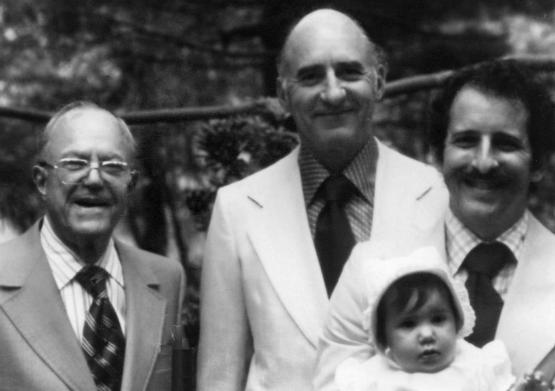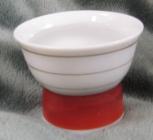  The photo above shows four generations of Krakauers. I hope my great-grandfather Philip was not as much of a sourpuss as he appears. I knew him when I was a very young child, but not very well - he died when I was four. It was Philip who came to the United States from the village of Bielsk in Poland, and who started the family business. Originally called Kay Manufacturing Corporation, it eventually grew to make innerspring constructions for mattresses. He passed the business on to his son Abe, who was born in New York City, and who had four sons himself. The three older sons worked all their lives for Kay, and the oldest, my father Daniel, ultimately became its president. Within the company, Abe was called "AK". Note 1 My closest relationship with my grandfather Abe was when I was quite young. I was his first grandchild, and I recall his taking me to his personal barber for haircuts. These ended with my hair styled up into a "pompadour", accomplished with the use of a rather thick pomade which my grandfather used on his own hair. In my somewhat hazy recollection, I think Abe did this final combing himself, rather than by directing his barber. Note 2 I saw my grandparents a great deal in those days, because we lived in an apartment in Brooklyn (New York) that was right around the corner from their house on Cortelyou Road. I saw them less frequently after we moved out to Great Neck, on Long Island, when I was about eight years old. But I still enjoyed visiting their house in Brooklyn from time to time. I recall sending a "Slinky" down their stairs, which was a particular treat because our modernist house in Great Neck was entirely on a single level, and hence had no stairs at all. It didn't even have a basement, so to use the Slinky in Great Neck, I had to build up stair-like stacks of books (which, as a future engineer, I did). Of course, Abe was present at almost all our family gatherings, but it occurs to me now that I never really got to know him very well as I became an adult. Working for your father can be awkward, a fact which his son, my father, made rather clear to me. When I got older, I heard from time to time about some of his frustrations about working for his own father. Thus I never thought it would be a good idea to join him in the family business, nor did my father ever particularly urge me to do so. My cousin Gary, however, did join the company. When it was ultimately sold to Leggett & Platt in 1985, Gary became president of bedding components for their northeast division. I don't know the details of any problems my father had working for Abe, nor did my father share most of them all with me. But there is one particular story I do recall. The company was considering two possible machines for the manufacture of a certain type of spring. Springs are manufactured by coiling wire into the desired shape, and one of the machines left a little bit of extra wire attached to the spring, which was used to hold onto the spring during subsequent stages of processing. Ultimately, it was chopped off and discarded. My father considered this machine to be substantially superior to the alternative. But Abe was dead set against it. Perhaps because he was only one generation removed from the "old country", one of the things he couldn't stand was waste. He thought the machine that discarded a little piece of wire for each spring it manufactured was "wasteful", and he absolutely refused to buy it, even though it was the most cost-effective machine available. My father pointed out, to no avail, that the piece of discarded wire was not actually "wasted". Scrap steel is not just thrown in the garbage, but rather is ultimately returned to a steel company to be melted down and recycled. Gary shared a similar story with me: "I have one vivid recollection about AK's distaste for waste. He believed that there were certain office supplies that the office manager overbought. One was paper clips. Since paper clips for the most part didn't leave the office, AK believed that if you tracked the route of their circulation and redistributed them periodically you shouldn't have to buy them. I was responsible for the three person receptionist/typing pool in Syosset. One of my jobs was to make sure that when the three women who worked for me accumulated paper clips, they would gather them and return their excess to the source (usually executives who were giving the women back-up information along with dictation)." I have another recollection of Abe when he was a bit older. My aunt Barbara arrived for some family gathering, and Abe happened to open our front door for her. She was wearing a dress with a long decorative zipper running down the front, with a large circular ring on the zipper-pull at the top. Abe couldn't resist this. Saying, "Hi, Bobbie", he pulled down on the ring, opening the zipper (and the dress).
Abe continued to work beyond his ninetieth birthday, which didn't particularly please my father, who wished he would retire. For a long time, Abe drove to work himself, which became problematic as his vision began to weaken, and he began to lose his hearing. It was my mother who put a stop to this after he had a couple of accidents on the Long Island Expressway. She arranged to accompany him to a doctor's appointment, where she "casually" mentioned to the doctor that he was still driving. The doctor basically replied, "He's what??!!" Abe still wouldn't retire, and the company arranged for a car to drive him to work every day. Ironically, after my mother died, we found among her possessions a copy of her ophthalmologist's eye chart. Apparently, she had memorized the chart so that she could pass her vision test, and thereby keep her drivers license. Click the next link for a biography of Abe that appeared in the trade magazine "Bedding" in honor of his ninetieth birthday. Gary recalled Abe's activities on the job in his later years. Gary wrote, "AK opened the mail and distributed it. He was very critical of mail that came in from our other locations which was sloppily stuffed into envelopes. Often he would write notes to managers asking them to remind the mailroom that the person receiving the mail was a person too, whose job should be respected and could be made easier by being neat. AK tallied all the incoming checks before giving them to the credit manager for entering against the customer accounts (for 12 years I was that credit manager). He would compare his count to what I gave to the accounting department and then enter the amount into a spreadsheet he kept manually. He signed all the checks as well, and logged that number into his spreadsheet. In this way he kept track of the cash flow on a daily basis. Dan's quote in the Bedding magazine article about AK's knowledge of the cash flow of the company is right on." Gary added, "I spent a lot of time with AK at the office. I was his back-up for some of the work he performed. He had a sharp mind all the way to the end when he suffered his stroke." My grandmother, née Ida Epstein, was born in Glusk, in what is now Poland. She was brought to the United States as a girl in 1904 (she spoke English with an accent), and settled with her family in Lincoln, Nebraska, a rather unusual destination for immigrants. But at some point, she was packed off to become a seamstress in New York City, with the specific objective of finding a husband (there were not a lot of eligible Jewish men in Lincoln). She obviously succeeded at this task, marrying Abe on March 5, 1914 (he was 21, and she was a year or more older). My aunt Blossom reported that Abe paid for the rest of Ida's family to come to the US. Note 3 My cousin Steve Krakauer recalls, "I remember there being a 70th [wedding] anniversary party at your folks' house in Great Neck. Your dad told the story that when he went to pick up the cake, the inscription said 'Happy 70th Birthday', because they couldn't believe that anyone could be married for 70 years to the same person!" Below is another four-generation photo showing Abe, on the left, at age 83. That's me on the right, holding Abe's first great-grandchild, my daughter Elissa. We're all dressed up - the picture was taken at my sister Phyllis's wedding.    Note 1: The company's name was changed from "Kay Manufacturing" to "Kay Springs" in 1979. My cousin Gary notes, "What actually prompted the change was the opening of a plant/warehouse in Chicago. There was already a company in Illinois with a registered name of Kay Manufacturing Corp. and we couldn't use that name. Rather than set up a subsidiary with a different name in Illinois, our collective dads and uncles decided to change the name of the company. The new name did better represent what we did and it was spiffier." [return to text] Note 2: My dictionary describes a "pompadour" as "A hair style with the hair brushed up from the forehead, invented by the Marquise de Pompadour". The Marquise de Pompadour (1721-1764), whose original name was Jeanne Antoinette Poisson, was a mistress of Louis XV of France. [return to text] Note 3:
And a sizeable family it was. The children of Moshe and Rochel (Rachael) Epstein, all born in Glusk (in Poland) were Israel (or Isadore), Dora, Ida, Jennie, Sarah, David, Fannie, and Bessie. Ida, who lied about her age all her life, always told us she was younger than Jennie, but according to Bessie, that was not the case. [return to text]
 |
